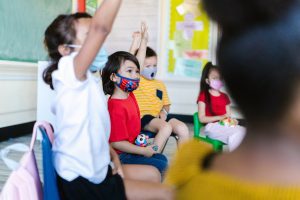Action for Healthy Kids’ Back in School Resources
Planning for the Next Normal at School Playbook
 As schools and districts across the nation settle back into in-person learning, they are facing an even greater strain as they seek to meet the diverse academic and health needs of students, staff, and teachers.
As schools and districts across the nation settle back into in-person learning, they are facing an even greater strain as they seek to meet the diverse academic and health needs of students, staff, and teachers.
To assist schools in proactively addressing the health needs of the school community, more than 30 nationally recognized and trusted school health organizations came together to develop a playbook support health in schools — “Planning for the Next Normal at School: Keeping students, staff, and families safe and healthy.” This guide aims to equip school and district leaders with specific, evidence-informed guidance and operating procedures for keeping school communities mentally and physically safe as we shape a new approach to learning. Each chapter of the playbook includes five “starter plays” that provide practical strategies and actionable steps for improving health in both in-person and virtual school environments.
Action for Healthy Kids is pleased to partner with Kaiser Permanente Thriving Schools and the National School Health Collaborative on the Back to School, Back Together campaign that provides the Planning for the Next Normal at School Playbook and information to support COVID-19 vaccination and recommended immunizations.
The Planning for the Next Normal at School playbook is an evolving collection of recommendations, co-authored by Alliance for a Healthier Generation, Action for Healthy Kids, Healthy Schools Campaign, and SHAPE America to address the total health needs of the school community. The playbook provides a framework to understand, assess, and implement strategies for COVID-19 prevention; social drivers of health; physical activity, physical education, and health education; staff and teacher well-being; mental health and well-being; and family well-being.
Check out this video featuring an interview with Sean Wade, our Director of Family-School Partnerships, about the importance of the playbook.
Return to School Roadmap
The U.S. Department of Education released the “Return to School Roadmap,” a resource to support students, schools, educators, and communities as they prepare to return to safe, healthy in-person learning this fall and emerge from the pandemic stronger than before. The Roadmap provides key resources and supports for students, parents, educators, and school communities to build excitement around returning to classrooms this school year and outlines how federal funding can support the safe and sustained return to in-person learning.
AFHK is promoting the federal government’s proactive approach to providing information and user-friendly tools in the Roadmap which aligns with CDC’s Guidance for COVID-19 Prevention in K-12 Schools. These agencies identify critical COVID mitigation strategies including student vaccinations (currently for 12+ years).
The Roadmap includes three “Landmark” priorities that schools, districts, and communities are encouraged to focus on to ensure all students are set up for success in the 2021-2022 school year. These include: (1) prioritizing the health and safety of students, staff, and educators, (2) building school communities and supporting students’ social, emotional, and mental health, and (3) accelerating academic achievement.
For more information, see the White House Fact Sheet: Reopening Schools and Rebuilding With Equity to learn how the American Rescue Plan and other federal funds can be used by schools to implement safe return to school strategies.
CPSTF Recommends Classroom-based Physical Activity Interventions
The Community Preventive Services Task Force recommends two classroom-based interventions to increase physical activity: physical activity breaks (also known as “brain breaks”) and physically active lessons. A team of specialists in systematic review methods and physical activity research, practice, and policy selected and evaluated two published reviews.
Evidence showed physical activity break interventions increased physical activity among primary school students, and physically active lessons increased physical activity and improved educational outcomes. Both types of interventions were delivered by trained teachers who had access to web or video resources designed to engage students in exercises or dance routines.
Why is this important?
- Regular physical activity in childhood and adolescence improves strength and endurance, helps build healthy bones and muscles, helps control weight, improves cognitive function, and reduces risk of depression (HHS 2018).
- When youth are regularly physically active, they increase their chances for a healthy adulthood and reduce their risk for chronic diseases such as diabetes or hypertension (HHS 2018).
- Schools are uniquely suited to help students achieve the 60 minutes or more of moderate-to-vigorous physical activity daily recommended in the Physical Activity Guidelines for Americans.
The real power of these “brain breaks” in the day is that they allow the time for the brain to relax in-between concentration during class, and encode new information into long-term memory (encoding new memories). Otherwise, the “working memory” function of the brain’s hippocampus gets overwhelmed by information and isn’t locked into memory. The activity, restoration of attention, increased blood and oxygen flow, and lower risks for chronic diseases are the corollary benefits.
Categories: Making Change Happen, News & Press Releases, Social Emotional Health